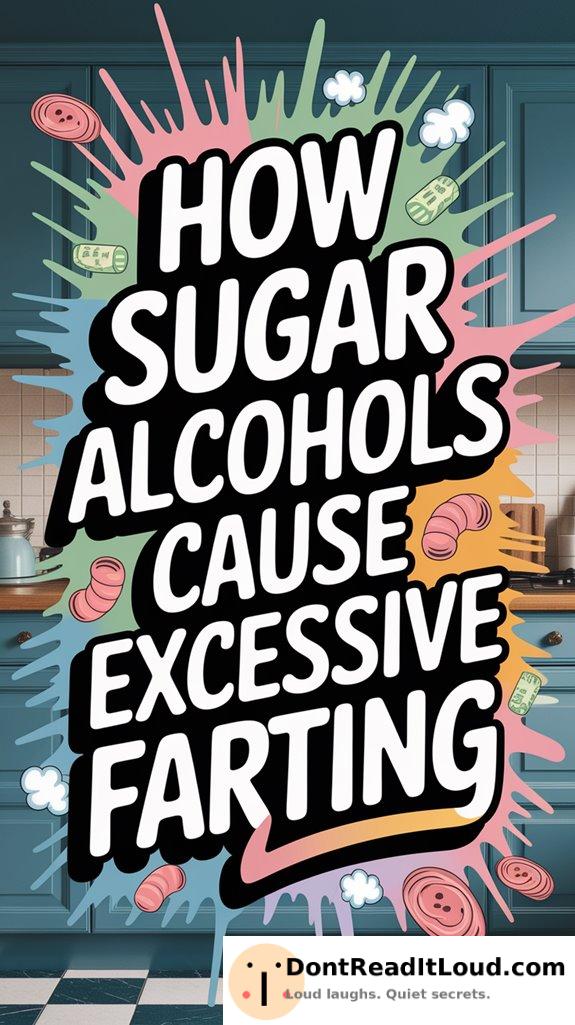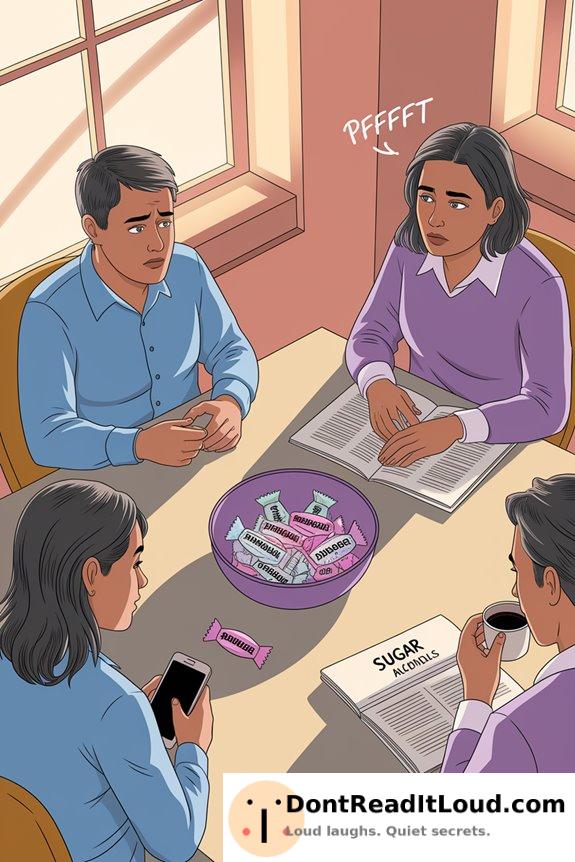
When you eat foods with sugar alcohols like sorbitol or xylitol, your body can’t completely digest them. These sweeteners travel to your colon, where gut bacteria break them down and create gases such as hydrogen and methane. This process can lead to increased gas or bloating, especially after sugar-free snacks. People react differently—some notice symptoms even with small amounts. Curious about which sugar alcohols are easier on your stomach or how to reduce discomfort?
What Are Sugar Alcohols and Where Are They Found?

Sugar alcohols are a type of carbohydrate that occur naturally in certain fruits and vegetables. You can find them in foods like berries, apples, pears, and some stone fruits.
Manufacturers often add sugar alcohols to sugar-free gum, candies, protein bars, and baked goods to provide sweetness with fewer calories. Examples of common sugar alcohols include xylitol, erythritol, sorbitol, and mannitol.
On ingredient labels, these may appear under total carbohydrates or listed separately as sugar alcohols. Knowing where sugar alcohols are found can help you identify them in your diet.
How Your Body Processes Sugar Alcohols

When you eat foods with sugar alcohols, your digestive system treats them differently than regular sugars.
Unlike simple sugars, sugar alcohols aren’t fully digested by your enzymes. Only part of them gets absorbed in your small intestine, while the rest travels further along your digestive tract.
Since your body can’t break down all of these compounds, a good portion escapes absorption. This incomplete digestion allows sugar alcohols to move deeper into your gut.
As a result, your body handles sugar alcohols less efficiently than regular sugars, which explains their distinct effects on digestion.
Why Sugar Alcohols Cause Gas and Bloating

Because your body can’t fully digest sugar alcohols, most of them reach your colon without being broken down.
Unlike regular sugars, they mostly escape digestion since your enzymes aren’t very effective at processing them. As these undigested sugar alcohols move through your gut, they tend to draw in more water, which can make you feel bloated.
Once they arrive in your colon, bacteria ferment them, producing gas and causing discomfort after you eat foods containing sugar alcohols.
The Role of Gut Bacteria in Sugar Alcohol Fermentation

Once sugar alcohols arrive in your colon mostly undigested, they encounter the vast community of bacteria residing there.
These microbes use the sugar alcohols as fuel, starting a fermentation process. Different gut bacteria vary in how effectively they break down these compounds.
As fermentation occurs, gases such as hydrogen, methane, and carbon dioxide are released. This can lead to symptoms like bloating and increased flatulence.
The types and amounts of bacteria in your gut affect how much gas forms, so your response to sugar alcohols can vary from others.
Common Types of Sugar Alcohols and Their Digestive Impact

Although sugar alcohols have similar structures, their effects on digestion can differ.
Sorbitol and mannitol often remain in the gut, leading to gas and bloating. Maltitol is also known for causing flatulence.
Xylitol can cause some mild discomfort, though it’s usually less troublesome than sorbitol.
Erythritol is mostly absorbed before reaching the colon, making it less likely to cause gas or digestive upset.
How Much Is Too Much? Recognizing Your Personal Tolerance

Even small amounts of sugar alcohols can cause digestive symptoms for some people, while others tolerate larger doses without issue.
Your personal sensitivity plays a major role in how your body reacts. Some notice gas or bloating after just a little, while others can eat more without discomfort.
Pay attention to your body’s signals—bloating, gas, or cramps may indicate you’ve exceeded your tolerance levels.
There’s no universal “safe” amount, so start with small quantities and observe how you feel.
Tips for Reducing Digestive Discomfort From Sugar Alcohols

If you want to enjoy foods with sugar alcohols without side effects, a few simple strategies can help.
Start by spacing out your intake—avoid eating large amounts at once. Eating sugar alcohols with a meal, instead of on an empty stomach, can make them easier to digest.
Gradually add these sweeteners to your diet so your body has time to adjust. Digestive aids like probiotics or enzyme supplements might help reduce gas and bloating.
Always check labels to see which sugar alcohols and how much are present. By being mindful, you can enjoy sweet treats while keeping digestive discomfort to a minimum.
Conclusion
If you’re noticing extra gas after eating foods with sugar alcohols, you’re not alone. These sweeteners are a favorite food for gut bacteria, which can lead to bloating and flatulence. Because tolerance varies from person to person, pay attention to how your body responds and adjust your intake as needed. Reading labels and limiting portions can help you enjoy sweets without discomfort. Trust your body’s signals to guide your choices.



